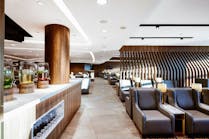It is testament to the hard work of operators across the world that customer satisfaction levels in airports grew across seven key areas last year – access, check-in, passport/ID control, security, way finding, airport facilities and environment.
According to the latest ACI barometer, people reported better experiences at every touch point, especially in airports where passenger numbers exceeded 40million – something that could be directly linked to more investment in infrastructure.
The report noted that passport and ID control remains the highest-performing touch point, with helpful staff members highlighted as the main reason. Even though airport facilities (retail and hospitality outlets) received the lowest satisfaction score, the category also saw the most improvement compared to last year. No doubt many airport operators will now be striving to boost satisfaction levels further by offering a wider choice of outlets and price points.
Rising passenger numbers
Last year, air traveler traffic jumped by around six percent compared to the previous year, while the world’s 20 busiest airports saw just under a 5 percent rise, with more than 1.5 billion passengers using these airports.
This upward trajectory is expected to continue as the IATA is forecasting further increases in the number of trips people take in a year. Driving this growth is China and India, which will account for 44 per cent of additional air passenger journeys.
Airport operators are well-aware of both the challenges and opportunities that come with large passenger volumes, particularly during holiday seasons.
Although some people have little choice but to travel from a certain airport, there is still no room for complacency. Long wait times – even if tolerated – leave holidaymakers with few opportunities to make last-minute purchases at the retail concessions, nor for retailers to capitalize on their good mood.
In today’s connected world, delivering positive experiences and driving repeat visits are essential when there are other airports (and modes of transport) available – and this means keeping waiting times and congestion to a minimum. Stores and restaurants rely on passenger spend, while the airports themselves depend on the rental income they receive from these businesses.
Crowd management
All this demonstrates the clear commercial incentive to move people through the terminal as quickly as seamlessly as possible.
Applying practices and tools more commonly associated with retail, such as people counting and queue management systems, we can forecast when footfall will be at its highest and in what areas. Real-time footfall data removes the guesswork and allows both managers and head office teams to make evidence-based strategic and operational decisions.
Just as a store manager can bring in more associates during the Black Friday and Christmas rush, so too can airports deploy additional staff at check-in and security at peak periods.
Passenger volumes might fluctuate on a daily or even hourly basis, depending on when flights are scheduled. As a result, operations managers need an accurate picture of what is happening on the ground if they are to implement changes quickly and effectively.
Queue management systems are another way to improve people flow in airports. Staff members no longer have to manually direct people to different lanes; as automated call forward systems can show them which one to use as soon as it becomes available. Audio-visual prompts provide clarity in areas where it is most needed.
It means staff can be deployed in other areas, enabling them to be agile in responding to changing situations while giving them insights that feed into future planning. By providing clear, logical routes for people to follow, operators avoid chaotic scenes air travelers and staff dread.
The cost of long waiting times
People counting and queue management systems put both retailers in a strong position to drive conversions, increase satisfaction and reduce the chances of reputational damage that comes when a customer walks out empty-handed.
The same is true of airports, although it could be argued that passengers who want to board their flight do not have the luxury of walking away. Nevertheless, they could avoid the airport in the future and tell their friends and family to do the same. Even if their frustration is minimal, retailers and restaurants are still going to bear the brunt of reduced spend when there is no time for people to enjoy a meal or go shopping.
Of course, brands that see their sales suffer because of regular delays will surely question why they are renting a unit in the first place. The airport not only loses much-needed rental income when concessions pull out, it also impacts negatively on the passenger experience. With limited choices on where to eat and shop, passengers may spend little or no money, or else choose another airport.
Putting it into practice
We recently worked with Edinburgh Airport in the UK to implement queue management systems at the departures security checkpoint to avoid congestion. Rather than relying on a human associate to guide people to the next available spot, the automated system uses audio-visual prompts to manage the line. As well as speeding up the process, and ensuring higher levels of passenger satisfaction, the system provides data for managers to optimize staff rotations and even the physical layout of airports.
Final thoughts
The fact that many airports have almost become shopping destinations in their own right only underlines the importance of maximizing sales opportunities. By 2021, global spending is expected to grow by 27% to $49 billion – which means operators must have the infrastructure in place to support positive experiences from the minute they park their car until the time their flight departs.
When looking for units in airports, and the lease negotiations begin, brands naturally want to know how much footfall the airport sees and details on dwell times. As we have seen, a busy airport opens up valuable sales opportunities as long as passenger volumes are managed effectively – and high footfall does not necessarily equate to long dwell times if there are unnecessary hold-ups on the journey.
Knowing exactly how people move through the airport, and putting systems in place to reduce queuing, can inform the physical layout of an airport, including wayfinding and barriers to manage flow and reduce confusion.
It is also the first step in securing contracts with the type of brands that transform airports into retail and leisure destinations. By striving to deliver passenger satisfaction at every touchpoint, the benefit for operators is two-fold: repeat visits from passengers and increased spend at retail concessions, which in turn drives up revenue and could help them win new and repeat contracts.
Peter Luff is president of global queuing and footfall insights and analytics company Ipsos Retail Performance.



